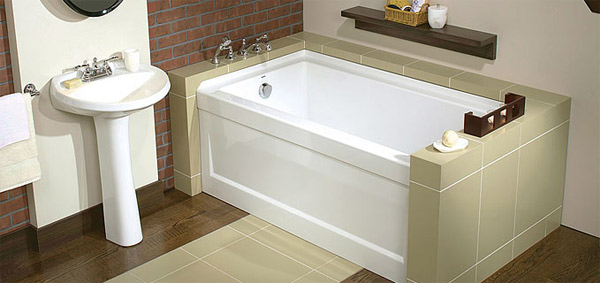5 Acrylic Washroom Issues and Solutions
5 Acrylic Washroom Issues and Solutions
Blog Article
{This Page Listed here down the page you can find a bunch of superb information in regards to Hiring a Plumbing Company. We recommend that you clean your acrylic bathing product made of Delta ProCrylic or Acrylic with Innovex Technology with non-abrasive soaps and cleaners, such as: When it’s time to clean, always use a terry cloth towel, soft cloth or sponge to avoid scratching the acrylic surface. Don’t use abrasive scrubbing pads, steel wool or sponges, cause permanent damage to the acrylic material. If you use a drain cleaner or clog remover, be sure to rinse thoroughly with water so no product is left standing near the drain. Some chemicals and cleaners may deteriorate acrylic surfaces, causing cracks and, potentially, property damage. To avoid this, don’t use cleaning products that state on their label that they are not suitable for use on Acrylic, ABS, Polystyrene or Plastic. Be sure to check the label of any product before you apply it to the surface; it’s easier to avoid damage than to try to remedy it. Chemicals we do not recommend using to clean acrylic showers/tubs: When you’re ready to apply sealant, a little planning goes a long way. Pick up some painter’s tape and use it to mask off the seam to help make cleaning up easier. When you’re applying the bead, use a constant, steady speed to avoid an uneven finish. Use a caulk tool or a plastic spoon to work the sealant into the joint. Wetting the tool with denatured alcohol will help create a smooth finish. Follow the directions on the back of the tube for cure time. Certain chemicals and cleaners may deteriorate acrylic surfaces, causing cracks and, potentially, property damage. After you’re finished applying it, clean up the product surface and remove any excess sealant with denatured alcohol. Don’t use solvents (turpentine, lacquer thinner, mineral spirits, paint thinner, MEK, xylene, acetone, naphtha, etc.) that can wreak havoc on an acrylic surface. With a little care and consideration, you can prevent damage to your acrylic shower or tub. Keep a supply of soft cloths handy and remove any damaging products or abrasive scrubbing items from the bathroom to ensure they aren’t around when it’s time to clean. https://www.deltafaucet.com/design-innovation/inspiredliving/how-to-clean-acrylic-shower Hopefully you enjoyed reading our excerpt on Hiring a Plumbing Company. Thank you for taking a few minutes to read our short article. Sharing is caring. Helping people is fun. We value reading our article about 6 Things to Know About When Hiring a Plumbing Services./ShowerStall-5b2ea923a9d4f900370b1241.jpg)
Acrylic bathrooms, shower trays, as well as other acrylic bathroom ware have become more usual in bathrooms in current times. Not as stylish as well as resilient as enamel as well as porcelain bathrooms and also components, they are a lot more cost effective and serve quite much the very same basic purpose. Some common instances of damage to acrylic restroom components consist of discoloration, fractures, holes, etc.Damaged shower or bath surface
Acrylic shower room components are not abrasion-resistant like enamel ranges. Being a very soft product, acrylic scrapes can even be hidden without coating or filling. For these, you should look for expert help for your bath repair work.Chemical Reactions
In some cases, people try to repaint the entire surface area of their acrylic bath by themselves either since they do not like the color to hide imperfections. Nevertheless, when they do not such as the end result, they use paint removers. You need to never ever use paint eliminator on acrylic bathrooms. Paint cleaners do not react with the surface of steel baths, they ruin acrylic bathrooms irreversibly. This develops a lot more benefit the expert. The most effective strategy here is to call an expert for aid with replacing the bathroom.Bath Discoloration
With extended usage of acrylic baths comes staining or discoloration. While some discolorations can be eliminated easily, using unique chemicals, others require that the bath be resprayed. Aromatherapy oils loosen the dirt in some situations thereby restoring the bathroom to its former glory.Cracked Polymer Baths
The lifespan of acrylic as well as fiberglass bathrooms is up to 15-20 years for shower frying pans and also baths, typically. Fractures in an acrylic shower tray are possibly amongst the easiest problems to repair for a repair service expert. This is the very same for PVC, material, as well as various other such products.
Acrylic baths, shower trays, as well as other acrylic washroom ware have actually ended up being much more common in restrooms in recent times. You should never ever use paint cleaner on acrylic baths. Paint cleaners do not respond with the surface of steel baths, they destroy acrylic bathrooms irreversibly. With extended usage of acrylic bathrooms comes discoloration or discoloration. The life-span of acrylic as well as fiberglass baths is up to 15-20 years for shower frying pans and also baths, generally.How to clean Acrylic shower
USE THESE NON-ABRASIVE CLEANERS
DO NOT USE THESE CLEANERS
Sealant Application Tips

Schedule Services